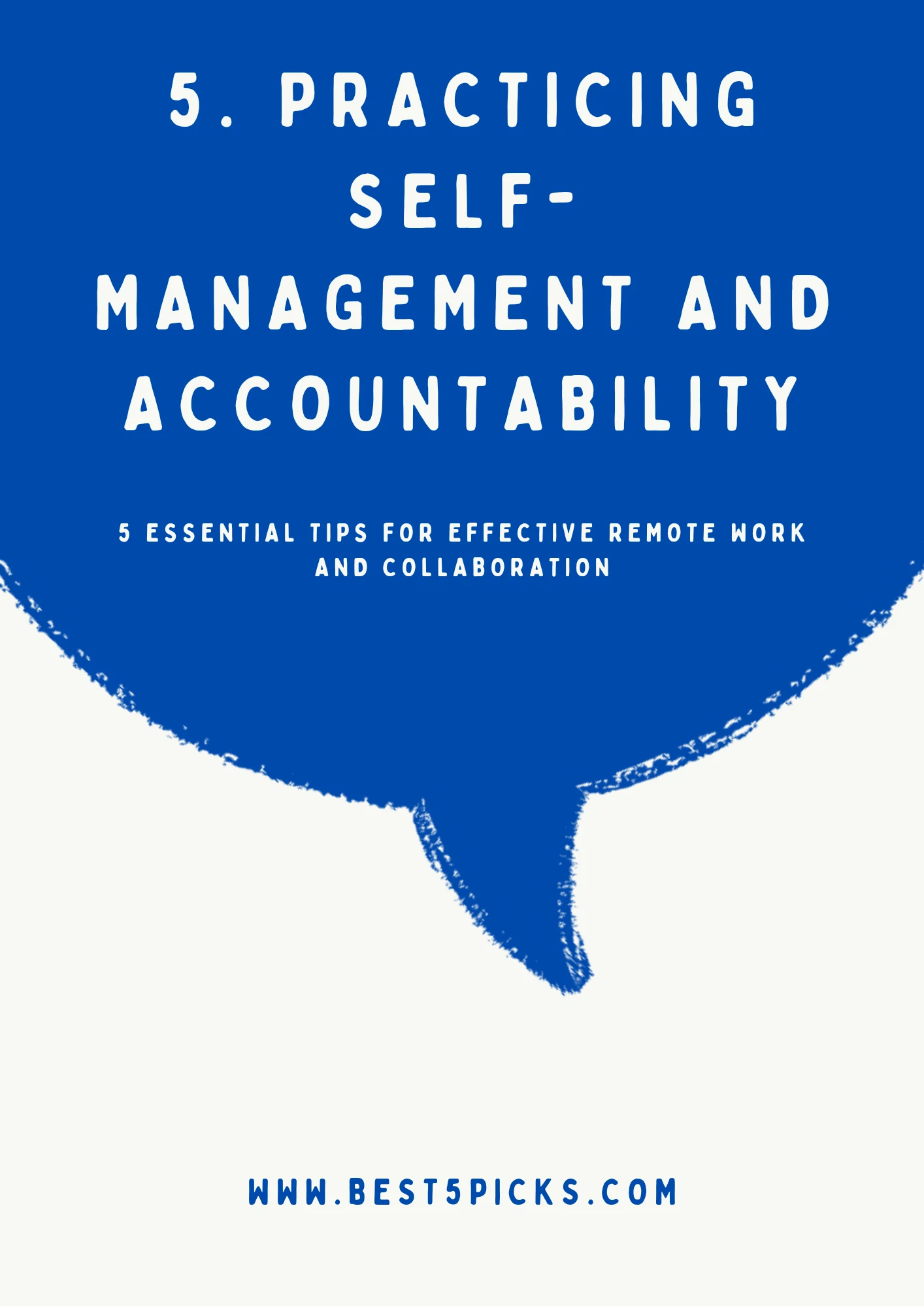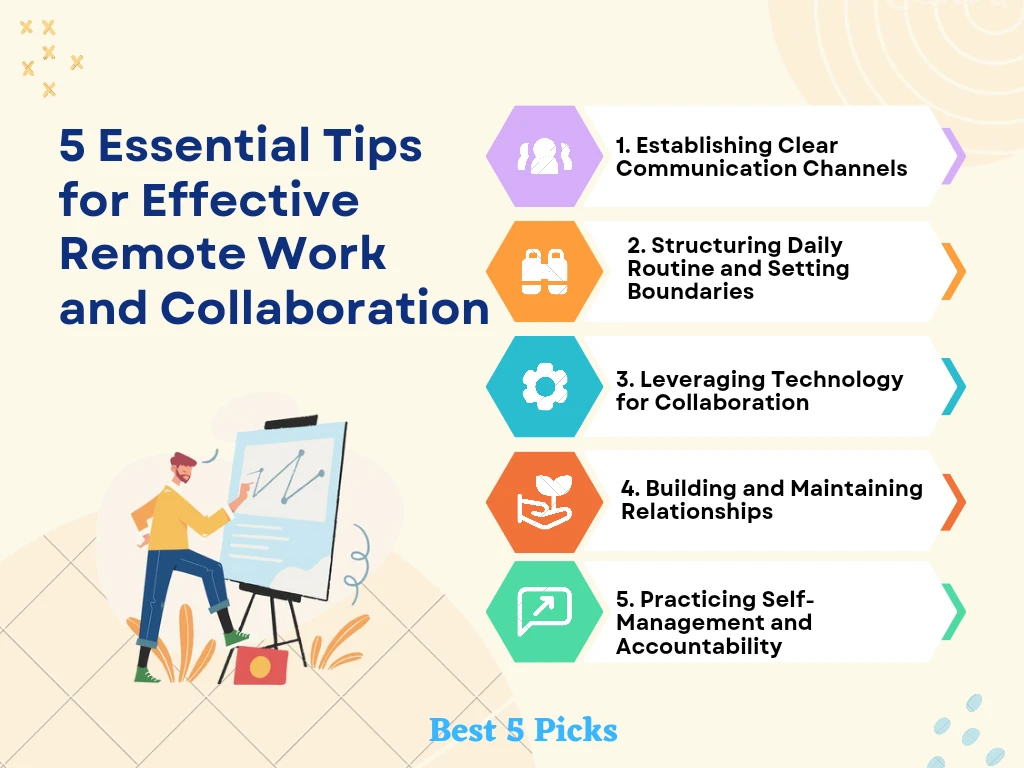Looking to enhance your remote work game? Check out these 5 tips for effective remote work and collaboration.
Discover strategies to streamline your workflow, boost productivity, and foster seamless collaboration with your remote team.
From communication tools to time management techniques, this article has got you covered. Dive in and revolutionize the way you work remotely!
In today’s digital age, mastering remote work and collaboration is essential for success. With these five expert tips, you’ll learn how to overcome common challenges and harness the full potential of remote work.
Whether you’re a seasoned remote worker or just getting started, these insights will help you stay connected, organized, and productive, no matter where you are.
I. Introduction
Unleash Your Productivity: Master Remote Work with These 5 Game-Changing Tips! Say Goodbye to Distractions and Hello to Success.
A. Definition of remote work and collaboration
Remote work refers to a work arrangement where employees or team members perform their tasks and responsibilities from locations outside of a traditional office environment. Instead of being physically present in the same workspace, remote workers utilize technology to communicate, collaborate, and complete their work remotely.
Collaboration, in the context of remote work, refers to the joint effort and cooperation between individuals or teams to achieve shared goals or complete projects. It involves working together, sharing ideas, information, and resources, and collectively making decisions to accomplish tasks or solve problems.
Remote work and collaboration have become increasingly prevalent in recent years, driven by advancements in technology, changing work cultures, and the need for flexibility and cost savings. The ability to work remotely and collaborate effectively has become essential for individuals and organizations to thrive in today’s global and interconnected work environment.
In the following sections, we will explore essential tips for ensuring effective remote work and collaboration, focusing on strategies to establish clear communication channels, structure daily routines, leverage technology, build and maintain relationships, and practice self-management and accountability.
By implementing these tips, individuals and teams can overcome the challenges of remote work and achieve high levels of productivity and collaboration.
B. Growing trend of remote work
The way we work has undergone a significant transformation in recent years, with remote work becoming a growing trend in various industries and sectors.
Remote work refers to the practice of working outside of a traditional office setting, often from the comfort of one’s home or any location that offers flexibility and connectivity.
This shift in work dynamics has been fueled by advancements in technology, increased globalization, and changing employee expectations.
1. Advancements in Technology:
- The widespread availability of high-speed internet has made it easier for employees to stay connected and collaborate with their colleagues from anywhere in the world.
- Communication tools such as video conferencing, instant messaging, and project management software have bridged the gap between remote teams, enabling seamless collaboration.
2. Globalization and Access to Talent:
- Organizations are no longer limited to hiring talent within their geographical proximity. Remote work allows companies to tap into a global talent pool, accessing specialized skills and diverse perspectives.
- Remote work has also enabled businesses to establish a presence in multiple locations or expand into new markets without the need for physical office spaces.
3. Changing Employee Expectations:
- Many professionals now prioritize a healthy work-life balance, and remote work offers the flexibility to accommodate personal needs while maintaining productivity.
- The younger workforce, in particular, values the freedom and autonomy that remote work provides, leading to increased demand for remote job opportunities.
The COVID-19 pandemic further accelerated the adoption of remote work, as organizations worldwide were forced to embrace remote work models to ensure business continuity and employee safety.
As a result, remote work has proven its viability and effectiveness, prompting many companies to consider permanent or hybrid remote work arrangements even beyond the pandemic.
In light of this growing trend, it is crucial for individuals and teams to adapt and develop effective strategies for remote work and collaboration.
By implementing the right practices and utilizing appropriate tools, remote workers can thrive and achieve success in their professional endeavors while enjoying the benefits of a flexible work environment.
C. Importance of effective remote work and collaboration
Remote work and collaboration have become increasingly important in today’s professional landscape.
With advancements in technology and shifting work preferences, more and more individuals and organizations are embracing remote work arrangements.
However, to ensure productivity and success in a remote work environment, it is crucial to prioritize effective remote work practices and foster collaboration among team members.
1. Enhanced Productivity:
Effective remote work practices can significantly enhance productivity. Remote workers often have the flexibility to create an environment that suits their individual needs, leading to improved focus and reduced distractions.
Additionally, remote work eliminates time-consuming commutes, allowing employees to allocate that time to their work. When remote workers are empowered to manage their schedules and work in a way that aligns with their strengths, they are more likely to achieve higher levels of productivity.
2. Access to Global Talent:
Remote work breaks down geographical barriers, enabling organizations to tap into a global talent pool. By embracing remote work, companies can access highly skilled professionals from different locations, bringing diverse perspectives and expertise to the table.
This access to global talent can enhance innovation, problem-solving, and overall team performance.
3. Cost Savings:
Remote work arrangements often lead to cost savings for both individuals and organizations. Employees can save on commuting expenses, meals, and professional attire, while organizations can reduce expenses related to office space, utilities, and equipment.
Remote work can also contribute to environmental sustainability by reducing carbon emissions associated with commuting.
4. Work-Life Balance:
Remote work allows individuals to have better work-life balance by providing flexibility in managing personal and professional responsibilities.
Employees can create schedules that accommodate their personal commitments, leading to reduced stress levels and increased job satisfaction. This balance contributes to higher employee retention rates and improved overall well-being.
5. Collaboration and Communication:
Effective remote work practices promote collaboration and seamless communication among team members. With the availability of various communication tools, remote workers can connect and share information easily.
Virtual meetings, instant messaging platforms, and collaborative document editing tools enable real-time interaction and collaborative work, fostering teamwork and innovation.
Effective remote work and collaboration are essential for the success of individuals and organizations in the modern work landscape.
Prioritizing clear communication, establishing routines and boundaries, leveraging technology, building relationships, and practicing self-management and accountability are key to thriving in a remote work environment.
By embracing these practices, individuals and organizations can unlock the numerous benefits that remote work offers and achieve greater productivity, efficiency, and satisfaction. “Discover 5 essential tips for effective remote work and collaboration” in this article. The Tips is Establishing Clear Communication Channels.
5. Practicing Self-Management and Accountability

A. Setting clear goals and deadlines
Setting clear goals and deadlines is essential for self-management and accountability in a remote work environment.
Here’s how to effectively set goals and deadlines:
1. SMART Goals: Set Specific, Measurable, Achievable, Relevant, and Time-bound (SMART) goals. Clearly define what needs to be accomplished, how progress will be measured, and set realistic timelines for completion.
2. Prioritization: Determine the most important tasks and prioritize them based on their urgency and importance. Break down larger goals into smaller, manageable tasks with their own deadlines to maintain focus and track progress.
3. Communication: Communicate your goals and deadlines to your team or supervisor. This ensures alignment and allows others to support and provide necessary resources or assistance.
B. Maintaining a structured workflow
Maintaining a structured workflow is crucial for self-management and maximizing productivity in a remote work environment.
Consider the following practices:
Daily Planning: Start each day by outlining your tasks and priorities. Create a to-do list or use task management tools to plan your workflow and track progress.
Time Blocking: Allocate specific time blocks for different tasks or types of work. This helps create a structured schedule, manage time effectively, and prevent multitasking.
Minimizing Distractions: Identify and minimize distractions that can disrupt your workflow. Close unnecessary tabs, mute notifications, and create a focused work environment to maintain concentration.
Breaks and Rest: Schedule regular breaks to recharge and avoid burnout. Take short breaks between tasks, practice mindfulness, or engage in physical activities to maintain focus and productivity.
C. Monitoring productivity and staying motivated
Monitoring productivity and staying motivated are key aspects of self-management and accountability.
Here’s how to effectively monitor productivity and maintain motivation:
1. Track Progress: Regularly assess and track your progress towards your goals. Use productivity tools or time tracking apps to monitor how you spend your time and identify areas for improvement.
2. Celebrate Milestones: Celebrate your achievements and milestones along the way. Recognize your progress and reward yourself for meeting deadlines or accomplishing goals. This helps maintain motivation and a positive mindset.
3. Find Motivational Techniques: Discover techniques that boost your motivation. This can include setting rewards for completing tasks, visualizing the end result, or finding external sources of inspiration, such as podcasts or success stories.
4. Seek Support and Accountability: Share your goals and progress with a trusted colleague or mentor who can provide support and hold you accountable. Regular check-ins or progress updates with them can help you stay motivated and committed.
By setting clear goals and deadlines, maintaining a structured workflow, and monitoring productivity while staying motivated, remote workers can effectively manage themselves and remain accountable for their work.
These practices contribute to a sense of accomplishment, productivity, and professional growth in a remote work environment.
4. Building and Maintaining Relationships

A. Engaging in virtual team-building activities
Building strong relationships within a remote team is crucial for effective collaboration and a positive work environment.
Here are some ways to engage in virtual team-building activities:
1. Icebreaker Activities: Start meetings or virtual gatherings with icebreaker activities that allow team members to get to know each other on a personal level. This can include sharing interesting facts, playing virtual games, or participating in virtual team-building exercises.
2. Virtual Social Events: Organize virtual social events such as virtual happy hours, coffee breaks, or team lunches. These informal gatherings provide opportunities for team members to socialize, bond, and have casual conversations beyond work-related topics.
3. Team Challenges and Competitions: Create team challenges or competitions that encourage collaboration, friendly competition, and teamwork. This can include virtual trivia nights, online escape rooms, or team-based projects that require cooperation and problem-solving.
B. Regularly scheduling virtual meetings and check-ins
Regular virtual meetings and check-ins are essential for maintaining communication, alignment, and team cohesion. Consider the following practices:
Regular Team Meetings: Schedule regular team meetings to discuss project updates, share important information, and address any challenges. These meetings promote open communication, allow for real-time collaboration, and ensure that everyone is on the same page.
One-on-One Check-ins: Conduct regular one-on-one check-ins with team members to discuss their progress, address individual concerns, and provide feedback. These check-ins foster a supportive environment, encourage professional growth, and strengthen the manager-employee relationship.
Informal Virtual Gatherings: Set aside time for informal virtual gatherings, such as virtual coffee chats or lunch breaks, where team members can connect on a more personal level. These casual interactions help foster rapport and build trust among team members.
C. Developing personal connections with colleagues
Developing personal connections with colleagues is vital for creating a positive and collaborative remote work environment. Here are some ways to cultivate personal connections:
1. Virtual Watercooler Discussions: Create virtual spaces or channels where team members can engage in casual conversations unrelated to work. These virtual “watercooler” discussions provide opportunities for personal connections to develop naturally.
2. Share Personal Updates: Encourage team members to share personal updates during meetings or team communication channels. This can include sharing hobbies, interests, or personal achievements. It helps team members understand each other’s lives beyond work.
3. Active Listening and Empathy: Practice active listening and empathy during team interactions. Show genuine interest in others’ thoughts, ideas, and concerns. Acknowledge and validate their experiences, fostering a supportive and inclusive work environment.
Building and maintaining relationships in a remote work environment requires intentional efforts. By engaging in virtual team-building activities, regularly scheduling virtual meetings and check-ins, and actively developing personal connections, remote teams can create a sense of camaraderie, collaboration, and mutual support.
These relationships contribute to improved teamwork, job satisfaction, and overall productivity in a remote work setting.
3. Leveraging Technology for Collaboration

A. Utilizing project management tools
Project management tools are essential for remote teams to streamline tasks, track progress, and foster collaboration. Here’s how they can be effectively utilized:
1. Task and Project Organization: Use project management tools like Trello, Asana, or Jira to create task boards, assign responsibilities, and set deadlines. These tools provide a visual representation of project progress and allow team members to track their tasks and dependencies.
2. Centralized Communication: Project management tools often offer features for team communication, such as comments or discussions within tasks. Utilize these features to keep project-related discussions organized and accessible to all team members. It helps ensure that important information and decisions are documented and readily available.
3. File Sharing and Document Collaboration: Many project management tools offer file-sharing capabilities. Utilize these features to share relevant documents, files, or assets associated with specific tasks or projects. This enables seamless collaboration and ensures everyone has access to the most up-to-date information.
B. Embracing video conferencing platforms
Video conferencing platforms play a crucial role in facilitating real-time communication, virtual meetings, and face-to-face interactions in remote work environments. Here’s how to effectively embrace these platforms:
Regular Meetings and Check-ins: Schedule regular video meetings with your team to discuss project updates, address challenges, and foster collaboration. These meetings help maintain team cohesion, clarify expectations, and promote a sense of connection among team members.
Screen Sharing and Presentation: Utilize the screen-sharing feature of video conferencing platforms to present information, share slides, or demonstrate processes. It allows for effective visual communication and ensures everyone is on the same page during discussions or presentations.
Virtual Collaboration: Leverage video conferencing platforms for virtual collaboration sessions, brainstorming sessions, or workshops. Use breakout rooms to divide participants into smaller groups for focused discussions or activities. These virtual collaboration features help replicate in-person interactions and enhance teamwork.
C. Implementing collaborative document editing tools
Collaborative document editing tools enable multiple team members to work on the same document simultaneously, regardless of their physical locations. Here’s how to effectively implement these tools:
1. Real-time Collaboration: Platforms like Google Docs, Microsoft Office 365, or Dropbox Paper allow multiple users to edit documents simultaneously. This promotes real-time collaboration, eliminates version control issues, and enhances productivity.
2. Commenting and Feedback: Utilize the commenting and suggestion features provided by these tools to provide feedback or collaborate on specific sections of a document. This allows for efficient communication and facilitates the exchange of ideas and revisions.
3. Document Versioning and History: Collaborative editing tools often provide versioning and revision history features. Take advantage of these features to track changes, revert to previous versions, or view the evolution of a document over time.
By effectively utilizing project management tools, embracing video conferencing platforms, and implementing collaborative document editing tools, remote teams can overcome geographical barriers and collaborate seamlessly.
These technologies facilitate communication, project organization, and document collaboration, ultimately enhancing productivity and teamwork in a remote work setting.
2. Structuring Daily Routine and Setting Boundaries

A. Establishing a dedicated workspace
Creating a dedicated workspace is essential for effective remote work. It helps create a productive environment and separates work from personal life. Consider the following tips:
1. Designate a Specific Area: Set aside a specific area in your home as your workspace. Ideally, choose a quiet and well-lit area with minimal distractions. Having a dedicated space helps signal to your brain that it’s time to focus and work.
2. Ergonomics: Ensure your workspace is ergonomically set up to support your posture and comfort. Use a comfortable chair, position your desk at the right height, and place your computer monitor at eye level to reduce strain on your neck and eyes.
3. Personalize Your Space: Make your workspace inspiring and conducive to productivity. Add personal touches such as plants, artwork, or motivational quotes that uplift your mood and create a pleasant atmosphere.
B. Defining working hours and breaks
Establishing clear working hours and breaks is essential to maintain a healthy work-life balance and prevent burnout. Consider the following suggestions:
Set Consistent Schedule: Define your working hours and communicate them to your team. Stick to a consistent schedule to establish a routine and manage expectations. This helps you and your colleagues know when you’re available for collaboration and when you need uninterrupted focus.
Plan Regular Breaks: Breaks are vital for maintaining focus and productivity. Schedule short breaks throughout the day to stretch, relax, or engage in activities that rejuvenate your mind. Avoid continuously working without breaks, as it can lead to fatigue and decreased productivity.
Communicate Boundaries: Clearly communicate your boundaries to your team and colleagues. Let them know when you are not available, such as during personal commitments or outside of working hours. Setting boundaries helps balance work and personal life and prevents work from encroaching on your personal time.
C. Avoiding distractions and maintaining focus
Remote work environments can be filled with distractions that can hinder productivity. Here are some strategies to stay focused:
1. Minimize Digital Distractions: Turn off notifications or use focus mode on your devices to minimize distractions from social media, email, or messaging apps. Designate specific times to check and respond to non-urgent messages or emails.
2. Create a Daily Routine: Establish a structured routine that includes specific blocks of time for different tasks. This helps create a sense of structure and discipline, making it easier to stay focused and avoid procrastination.
3. Practice Time Management Techniques: Use techniques such as the Pomodoro Technique, where you work for a focused period (e.g., 25 minutes) followed by a short break (e.g., 5 minutes). This helps maintain concentration and breaks tasks into manageable chunks.
4. Manage Your Environment: Minimize external distractions by creating a quiet and organized workspace. Use noise-cancelling headphones, if necessary, to block out noise. Communicate with family members or housemates about your need for uninterrupted work time.
By establishing a dedicated workspace, defining working hours and breaks, and implementing strategies to avoid distractions, remote workers can create an environment conducive to focus and productivity.
Structuring daily routines and setting boundaries contribute to work-life balance and overall well-being in a remote work setting.
1 : Establishing Clear Communication Channels

A. Importance of clear and regular communication
Clear and regular communication is crucial for effective remote work and collaboration. In a remote setting, team members are physically distanced, making it essential to establish open lines of communication to ensure everyone is on the same page.
Here’s why clear and regular communication is important:
1. Alignment and Clarity: Clear communication helps ensure that team members have a shared understanding of goals, tasks, and expectations. It allows for effective coordination and alignment of efforts, reducing misunderstandings and errors. When everyone is clear about their roles and responsibilities, productivity and efficiency are improved.
2. Building Trust: Remote work relies heavily on trust between team members. Regular communication fosters trust by providing opportunities for transparent discussions, sharing progress updates, and addressing any concerns or challenges. Trust is essential for effective collaboration and a positive team dynamic.
3. Problem Solving: Effective communication enables swift problem-solving. When team members can easily communicate with one another, they can quickly address issues, brainstorm solutions, and make informed decisions. Regular communication also promotes a proactive approach to problem-solving by identifying potential roadblocks early on.
B. Utilizing various communication tools
Utilizing various communication tools is essential for remote work to facilitate effective and efficient communication. Here are some commonly used tools:
Video Conferencing: Video conferencing platforms, such as Zoom, Microsoft Teams, or Google Meet, enable face-to-face interactions even when team members are geographically dispersed. Video calls allow for clearer communication, non-verbal cues, and a sense of connection, enhancing collaboration and team engagement.
Instant Messaging: Instant messaging platforms like Slack or Microsoft Teams provide real-time communication for quick questions, updates, and informal conversations. These tools are ideal for swift communication, sharing links or files, and fostering a sense of camaraderie within the team.
Project Management Tools: Project management tools like Trello, Asana, or Basecamp help organize tasks, assign responsibilities, and track progress. These tools centralize project-related information, making it easily accessible to all team members, promoting transparency and collaboration.
Email and File Sharing: Email remains an essential tool for formal communication, sharing detailed information, or documentation. File-sharing platforms like Google Drive or Dropbox enable seamless sharing and collaboration on documents, presentations, or spreadsheets.
C. Setting expectations for response times
Setting clear expectations for response times is crucial for effective remote work and collaboration. Remote teams often work across different time zones and have varying work schedules.
Establishing expectations regarding response times helps maintain productivity and ensures smooth communication. Consider the following aspects:
1. Define Reasonable Turnaround Times: Establish guidelines or policies that specify how quickly team members are expected to respond to messages or requests. Consider the urgency of the communication and the nature of the task when setting response time expectations.
2. Communicate Availability: Team members should communicate their availability and working hours to colleagues. This allows others to know when they can expect a response and avoids unnecessary delays or misunderstandings.
3. Prioritize Urgent Communications: Clearly communicate how urgent or time-sensitive matters should be handled. Differentiate between urgent requests that require immediate attention and non-urgent ones that can be addressed within regular working hours.
4. Flexibility and Understanding: Remote work often offers flexibility in terms of when and where work is done. Acknowledge that team members may have different schedules due to personal commitments or time zone differences. Encourage open communication and understanding regarding availability and response times.
By emphasizing the importance of clear and regular communication, utilizing various communication tools, and setting expectations for response times, remote teams can maintain effective collaboration, minimize miscommunication, and foster a productive work environment.
II. Conclusion
In this article, we have explored essential tips for effective remote work and collaboration.

A. Importance of adapting and finding what works best for each individual
It’s important to note that remote work is a dynamic environment, and what works for one person may not work for another. Each individual should adapt and find what strategies and techniques suit their work style and preferences.
Experiment with different approaches and refine them over time to enhance productivity and collaboration in remote work.
B. Encouragement for embracing remote work opportunities and maximizing productivity and collaboration
Embracing remote work opportunities offers numerous benefits, including flexibility, reduced commute time, and increased work-life balance.
By implementing the tips discussed in this article, remote workers can maximize their productivity, maintain effective collaboration with team members, and thrive in their professional endeavors.
Remember, remote work requires discipline, effective communication, and adaptability. With the right mindset, tools, and strategies, individuals can successfully navigate the remote work landscape and achieve their goals.
Embrace the opportunities remote work presents, continue to refine your approach, and make the most of your remote work experience for increased productivity, collaboration, and overall satisfaction.
III. Quick Recap of 5 Tips for Effective Remote Work and Collaboration
- Establishing Clear Communication Channels
- Structuring Daily Routine and Setting Boundaries
- Leveraging Technology for Collaboration
- Building and Maintaining Relationships
- Practicing Self-Management and Accountability
In conclusion, these essential tips for effective remote work and collaboration can help you maximize productivity and succeed in the remote work environment.
Adapt, find what works best for you, and embrace remote work opportunities for success.
IV. Frequently Asked Questions (FAQ)
Why is establishing clear communication channels important for remote work?
Clear communication channels ensure that everyone on the remote team is on the same page, reduces misunderstandings, and fosters efficient collaboration. It helps in timely exchange of information and promotes transparency in remote work environments.
How can I structure my daily routine effectively for remote work?
Structuring your daily routine involves setting specific work hours, scheduling breaks, and allocating time for different tasks. This helps in maintaining productivity and preventing burnout. Setting boundaries between work and personal life is also crucial.
What are some effective technologies for remote collaboration?
Technologies like video conferencing tools (e.g., Zoom, Microsoft Teams), project management software (e.g., Trello, Asana), and communication platforms (e.g., Slack, Microsoft Teams) are valuable for remote collaboration. These tools facilitate seamless communication, file sharing, and task management.
How can I build and maintain relationships while working remotely?
Building relationships remotely requires regular communication, both formal and informal. Schedule virtual coffee breaks or team-building activities, participate actively in discussions, and show appreciation for your colleagues’ work. Being responsive and supportive fosters a sense of camaraderie.
What does self-management and accountability entail in remote work?
Self-management involves organizing your tasks, prioritizing deadlines, and staying motivated without direct supervision. Accountability in remote work means taking ownership of your responsibilities, meeting deadlines, and communicating proactively about progress or challenges.
How can I ensure effective communication in a remote team?
Effective communication in a remote team involves using clear and concise language, actively listening to others, and utilizing appropriate communication channels (e.g., email, instant messaging, video calls). Regular check-ins and status updates can also help keep everyone informed.
What strategies can I use to avoid distractions while working remotely?
To avoid distractions, create a dedicated workspace free from interruptions, establish boundaries with family or roommates, and use productivity techniques like the Pomodoro method. Prioritize tasks, limit multitasking, and use tools that block distracting websites or apps if necessary.
How do I overcome feelings of isolation while working remotely?
To overcome feelings of isolation, actively engage with your colleagues through virtual meetings, chat platforms, or social events. Join online communities related to your field, participate in networking events, and seek out mentorship opportunities to stay connected professionally.
How can I maintain work-life balance in a remote work setup?
Maintaining work-life balance involves setting boundaries between work and personal life, scheduling regular breaks, and designating specific work hours. Create a separation between your workspace and living space, and make time for hobbies, exercise, and socializing outside of work.
What should I do if I encounter technical difficulties while working remotely?
If you encounter technical difficulties, troubleshoot the issue using available resources or seek assistance from your IT support team. Stay patient and communicate any delays or challenges to your team members. Having backup plans or alternative communication methods can also help mitigate disruptions.










